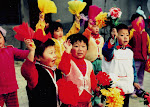 |
| Photos at Museum of the Horse Soldier |
The Horse Marines served to protect Americans in and around the
embassy in Peking (Beijing), the international community in Shanghai and the
legation at Tientsin (Tianjin) from 1909 to 1938. This protection of U.S.
citizens became especially important after the incident at Marco Polo Bridge in
July 1937 as the Japanese began their attach on Beijing.
These horse soldiers were mainly from the 4th
Marines; all were experts at using sabers and rifles. At one time, there were
1,500 Marines serving in the Horse Marines. The horses they rode were ponies from
Mongolia, because they were short and sturdy, perfect for riding around the
Chinese countryside.
The China Marines, as
these horse soldiers were called, disbanded in March 1938 at a review ceremony
at Breckenridge Field in Peking.
Pictures of the Horse Marines in China can be found on a
wall mounting at the Museum of the Horse Soldier in Tucson.











